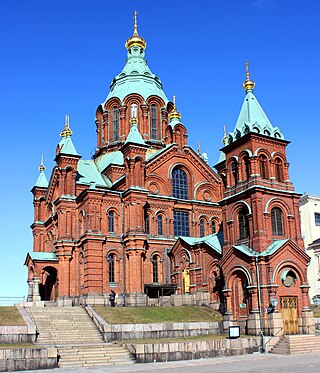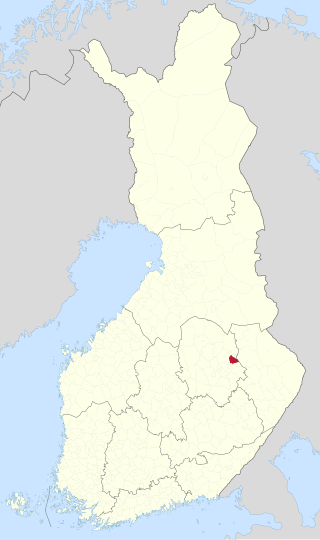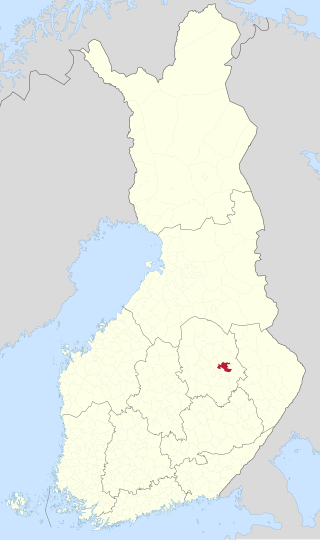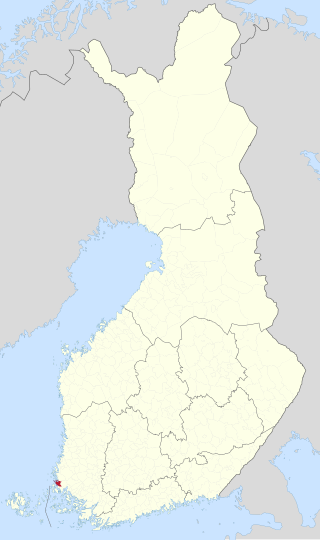
The Orthodox Church of Finland or Finnish Orthodox Church is an autonomous Eastern Orthodox archdiocese of the Ecumenical Patriarchate of Constantinople. The church has a legal position as a national church in the country, along with the Evangelical Lutheran Church of Finland.

Kuopio is a Finnish city and municipality located in the region of Northern Savonia. It has a population of 122,615, which makes it the 8th most populous municipality in Finland. Along with Joensuu, Kuopio is one of the major urban, economic, and cultural hubs of Eastern Finland. At the end of 2018, its urban area had a population of 89,307.

Ilomantsi is municipality and a village of Finland. It is located in the North Karelia region. The municipality has a population of 4,478 and covers an area of 3,172.69 square kilometres (1,224.98 sq mi) of which 409.01 km2 (157.92 sq mi) is water. The population density is 1.62 inhabitants per square kilometre (4.2/sq mi). The most eastern point of Finland and of the continental part of the European Union is located in Ilomantsi near the village of Hattuvaara.

Kaavi is a municipality of Finland. It is located in the Northern Savonia region. Kaavi is also a part of historical Karelia. The municipality has a population of 2,697 and covers an area of 789.59 square kilometres (304.86 sq mi) of which 115.49 km2 (44.59 sq mi) is water. The population density is 4 inhabitants per square kilometre (10/sq mi). It is 60 kilometres (37 mi) from Kuopio and 90 kilometres (56 mi) from Joensuu. Neighbouring municipalities are Kuopio, Juuka, Outokumpu, Polvijärvi and Tuusniemi.

Loimaa is a town and municipality of Finland.

Helsinki Cathedral is the Finnish Evangelical Lutheran cathedral of the Diocese of Helsinki, located in the neighborhood of Kruununhaka in the centre of Helsinki, Finland, at the Senate Square. The church was originally built from 1830 to 1852 as a tribute to the Grand Duke of Finland, Tsar Nicholas I of Russia. It was also known as St Nicholas's Church until the independence of Finland in 1917. It is a major landmark of the city, and possibly the most famous structure in Finland as a whole when viewed globally.

New Valamo or New Valaam is an Orthodox monastery in Heinävesi, Finland. The monastery was established in its present location in 1940. However, the tradition of the Valamo monastery dates back to 1717. The monastery was then originally established on Valaam which is an archipelago in the northern portion of Lake Ladoga, lying within the Republic of Karelia in the Russian Federation.

Uspenski Cathedral is a Greek Orthodox or Eastern Orthodox cathedral in Helsinki, Finland, and main cathedral of the Orthodox Church of Finland, dedicated to the Dormition of the Theotokos. Its name comes from the Old Church Slavonic word uspenie, which denotes the Dormition. It is the largest Greek Orthodox church in Western Europe.

The Holy Trinity Church is a Finnish Orthodox Church located in the Kruununhaka district of Helsinki, on the corner of Unioninkatu and Rauhankatu. The church was built in the neo-classical style in 1826 under the direction of the architect Carl Ludvig Engel, and was dedicated and opened in the following year. The Holy Trinity services the city's orthodox community with Divine Liturgy held in both Church Slavic and Finnish.

Turku Orthodox Church or the Church of the Holy Martyr Empress Alexandra is the main church of the Turku Orthodox parish located at the northwest corner of the Turku Market Square along the Yliopistonkatu street in Turku, Finland. The church was built under plans drafted by architect Carl Ludvig Engel and was ordered by Nicholas I of Russia on 5 January 1838. Construction, which began in 1839, cost 67,886 rubles and was completed in 1845. The church was consecrated on 2 September 1845. The church was dedicated to Alexandra, the spouse of Diocletian who had publicly become Christianised and suffered a martyr's death on 23 April 303. The choice of patron saint may have been due to Nicholas I's wife's name, Aleksandra Feodorovna.

North Eastern Savonia or Northeastern Savo is a sub-region of Finland. It is an administrative subdivision of the region of North Savo.

RIISA – Orthodox Church Museum of Finland is a museum located in the city of Kuopio, which specializes in the research, preservation and archiving of the visual and tangible cultural heritage of the Finnish Orthodox Church.

The Saint Joseph's Church It is a religious building located in Kuopio, a town in Finland, which is affiliated with the Catholic Church and was dedicated to St. Joseph.

The Great Cemetery of Kuopio is a large cemetery located in the Puijo district in Kuopio, Finland. The cemetery was founded in 1867 and has been expanded several times in the 20th century. The cemetery is located in the area of Kuopio Cathedral Parish and is also known as the Kuopio City Parish Cemetery. The cemetery is bordered on the south by the Kouvola–Iisalmi railway, on the west by the Blessing Chapels along Karjalankatu and the building of the Finnish Orthodox Church Museum and Ecclesiastical Government, on the north by the Highway 5, and on the east by Puijonkatu street.

The St. Nicholas Church is the main church of the Kotka Orthodox Church in Kotka, Finland, surrounded by the Isopuisto park The church was built between 1799 and 1801 according to the drawings of architect Jakov Perrin. The church dates back to the time of the active years of the sea fortress of Ruotsinsalmi, when the Russians built the Ruotsinsalmi–Kyminlinna double fortress in the Kymi parish and a fortress town was created on Kotkansaari. The church is the oldest building in present-day Kotka, and it is a notable representative of neoclassicism in Finland.

St. Nicholas Cathedral is the main church of the Kuopio Orthodox Parish in Väinölänniemi, Kuopio, Finland, and also the seat of the Orthodox Diocese of Karelia. The church was completed in 1903 and is dedicated to the memory of Saint Nicholas. The church, built between 1902 and 1903, was designed by the master builder Aleksander Isakson from Vyborg. The facade is plastered and painted to look like red brick, but there is also genuine brick under the plaster. In appearance, it resembles red-brick simultaneous garrison churches. The iconostasis was made at the Alexander Nevsky Lavra in Saint Petersburg and was donated by Nikolay Bobrikov, the Governor-General of Finland. There are eight bells in the cathedral.

Säyneinen is a village and a former municipality of Finland at the time of its existence in the Kuopio Province, now in Northern Savonia. Together with Muuruvesi, it was consolidated with Juankoski in 1971, since 2017 part of Kuopio.

Muuruvesi is a village and a former municipality of Finland at the time of its existence in the Kuopio Province, now in Northern Savonia. Together with Säyneinen, it was consolidated with Juankoski in 1971, since 2017 part of Kuopio.

Lokalahti is a village and a former municipality of Finland in the former Turku and Pori Province, now in the Finland Proper region. It was consolidated with the town of Uusikaupunki in 1981.

The Order of the Holy Lamb is a semi-official ecclesiastical order of Finland awarded by the Orthodox Church of Finland. Under the patronage of the Finnish state, its Grand Master is the Archbishop of the Orthodox Church of Finland. The order can be awarded to anyone regardless of religion or nationality who have made services to the Church.






















